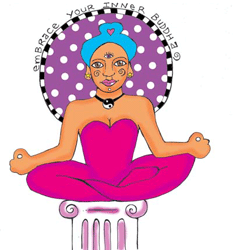Once you are clear in your mind why you are here today, you are ready to begin. Most beginnings are gentle. A period of meditation is nice. Sit, lie down, or sometimes stand in Mountain Pose – and meditate. Spend three minutes, or more if you are inclined, just to take inventory – note where you are starting from.
An inner inventory is very grounding. Begin by allowing your awareness to sink into your lower belly. From here notice the rhythm of your own breath. Feel the rising and falling of each inhalation and exhalation. Do not try to change anything – accept the breath exactly the way it is; just notice it.
To remain focused, you may want to mentally say “in” and “out” with each breath, or note to yourself “rising” and “falling.” Some people find it easier to follow the breath by noticing the movement of the air in and out of the body, the feeling of the air in the throat, or on the upper lip. Let your awareness linger wherever it is easier to stay with the sensation of the breath.


After a few breaths, allow your awareness to broaden. Notice other feelings in your body: your weight on the floor, the temperature of the air against your skin. You may even choose to allow yourself to simply listen to the sounds around you; listening is a wonderful way to be present. We don’t have to do anything to create the sounds; we just let them come to us – sounds from near or far, loud or soft. We just allow them in, without judging them as pleasant or unpleasant.
After a while, we bring our awareness higher, to the heart level. From here we check in with the state of our emotional body. This can be difficult; we are not well trained in our culture to notice or value our emotions. When asked, “What are you feeling right now,” most people can’t answer. They think they are feeling nothing. This is rarely so, but what is happening is that we are unaware of the state of our heart.
Emotions need not be big, dramatic feelings. Look closely and don’t dismiss anything that appears. The emotion may be as small as boredom. Perhaps there is a little bit of irritation about something that isn’t quite to your liking; impatience is a common emotion during our practice. And contentment can also appear from time to time. The key is just to notice what is arising, without judging yourself for whatever is there. Don’t criticize yourself for being bored or irritated; don’t congratulate yourself for being content. Just notice what is happening right now. Watch it change. Watch it.
After another minute or so, allow your awareness to rise even higher – to that point right between the eyes; feel that point. From here, start to pay attention to the thoughts arising in your head. Don’t try to stop the thoughts from coming; that is fruitless. Just watch each new one arise, notice it, and let it float away. Watch the next one come and go. Perhaps it will be helpful to label the thoughts. If so, just use a one- or two-word label such as “planning” or “remembering” or “imagining.” Again, don’t be judgmental about whatever thoughts do come up – just watch.
Beginning your practice this way is valuable because this is exactly what you will want to do during the asana practice. While you move into, and out of, and hold your postures – keep taking a new inner inventory. Notice how the practice affects you on the physical, emotional, and psychological levels. Accept whatever you find out. Just keep being curious. Begin to move your energy.
Yin Yoga removes the blockages deep in our connective tissues, allowing the Chi or prana to flow unhindered. But before the energy can flow, it has to be stimulated. In a yang practice we use movement to start this flow of energy, but that engages the muscles, which we try to avoid in the yin practice. To get the energy moving in Yin Yoga we can use other techniques. The chapter coming up on Moving Energy gives several ways to begin to move energy without engaging the muscles. If you plan to spend some time stimulating the energy flow, now is an ideal time – right after the opening meditation but before the first yin posture.
Once you have settled in for a few minutes, calmed the mind, and awoken your inner energy you are ready for the first asana. Now, we wonder – which asana comes first?
(Next: Sequencing )

